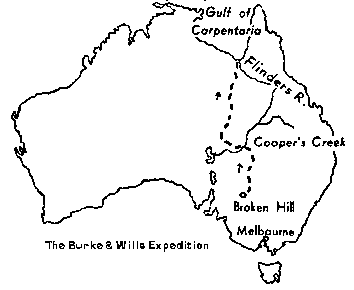The Gulf of Carpentaria
The Dutch (1600-1800)
The discovery of the areas now known as the Gulf Country was exclusively a Dutch maritime affair. By the beginning of the 17th century the Dutch East India Company was well established in the East Indies and was looking to extend its influence and increase its profits by searching out new sources of supply for the raw materials which the islands yielded so abundantly. In line with this policy the yacht 'Duifken' (Wn. Jansz, Captain) was dispatched from Bantam in 1605 to learn more about the lands and islands to the south, especially New Guinea. The expedition sailed down the south-west coast of New Guinea, missed Torres Strait entirely (the Strait was discovered by Torres in 1606) and entered the Gulf of Carpentaria. They sailed down the eastern gulf coast as far as Cape Keer-Weer, and then turned back to the islands.
The knowledge that an unknown coast lay to the south prompted the Dutch East India Company to send out another expedition in 1623. This time two vessels, the "Pera" and the "Aernem" under Jan Carstenszoon were despatched. The expedition extended discovery of the eastern gulf coast south to the Staeten (Steaten) River, landing at several points (principally for water) and gave the first descriptions of the northern coast of Australia.
The time of their visit was April and May, and they were not impressed with what they saw.
Detailed Coastal Exploration (1802-1842)
Mathew Flinders (1802) - Detailed examination of the Gulf coasts was carried out by British naval vessels in the first decades of the 19th century, but Britain's interests in the north were not aroused until Dutch and French activities prompted action. Cook, in 1770, had re-established the existence of Torres Strait, and Bligh's and Edward's voyages in these same waters kept the Cape in public and official mind.
By 1802 it was apparent that Britain had a real interest in the north and that more knowledge about the coastlines was urgently needed. The opportunity to prosecute such examinations came in 1802 when Matthew Flinders, in the refitted "Investigator", set sail from Port Jackson with instructions to examine Torres Strait and the coasts of the Gulf of Carpentaria.
Matthew Flinders arrived in the Gulf waters on November 3rd, 1802 in the "Investigator". For the next 2 & a half months he examined and chartered the Gulf Coast. Whilst in the Gulf Flinders blazed a tree on Sweers Island. It was 40 years before further exploration.
Captain J. Lort Stokes in the "Beagle" spent the period between the 29th June and 4th August, 1841 retracing Flinders route in more detail. Between July 30th and August 6th Stokes discovered the Albert River and ascended it for a distance of 50 river miles from the mouth in a long boat. He was much impressed with the level grassy plains dotted with trees which stretched endlessly to the south, which he named "The Plains of Promise". Stokes also visited Sweers Island and on finding the tree blazed by Flinders, he blazed the reverse side.
Dr Ludwig Leichardt's expedition in 1848 was next in the area. Forced by the topography to make a great sweep inland, the party crossed the Flinders and a river that Leichhardt mistook for the Albert. This was later named the Leichhardt by Augustus Gregory. The explorers were now 12 miles south of present day Burketown. They reached the actual Albert River on 18th August and came upon a "fine running brook" which Leichhardt named Beames Brook after Walter Beames, Esquire of Sydney.
In 1856 Augustus Gregory on his exploratory overland trip from Victoria River to Brisbane stopped on the Albert to meet with the "Sandfly", which was to resupply the party. Too impatient to wait, Gregory pushed on after burying letters at the foot of a marked tree. The schooner arrived in November.
After the disappearance of Burke & Wills, search parties were organised by Victoria, South Australia and Queensland. The Queensland Government sent Frederick Walker with a relief expedition overland. He and his party rode out of Rockhampton in September 1861 and headed west. William Landsborough and his party aboard the "Firefly" escorted by the "Victoria" set out for the Albert River on August 24 to set up a rendezvous and depot to meet with Walker. In October, 1861 they found trees marked by Augustus Gregory and Lieutenant Chimno of the survey ship "Sandfly" in 1856. They marked a line of trees to guide Walker's overland expedition to the depot on the Albert on the 7th December, 1861.

Map of Burke and Wills Expedition Walker contracted gulf fever and left Burketown heading south. He died at Floraville Station where his grave still exists today. The "Firefly" was the first known ship to enter the Albert River - it sank in a small inlet near the boiling down works.
Before leaving Burketown, Landsborough had Captain Norman of "HMS Victoria" buried provisions near a tree they blazed in case Burke & Wills returned. The tree still stands adjacent to the Boiling Down Works site.
John McKinlay, also searching for Burke & Wills, left Adelaide on the 16th August 1861 for the Gulf. In May, 1862 he followed the Leichhardt River down to salt water and camped 5 miles from the sea. Commander Norman and the "Victoria" had left the Albert some months before..
Map from Maier's "Burke & Wills"
Over the next 3 years the stations of Gregory Downs, Floraville, Beames Brook and others were taken up in the Gulf. It was obvious that a town and port was needed in the Gulf. Towns and Company chartered a small vessel the 'Jacmel Packet' and on 12 June, 1865 it arrived off the mouth of the Albert River. The goods were eventually landed on the present site of Burketown. By September 1865 the population was about 40 and by October a store and a hotel were under construction, the balance of buildings were humpies. Rations and grog were plentiful but already one evil was noted: prices for goods were so high that some intended settlers could not stay. The town grew; however currency, both notes and coins, were so short in early Burketown that the business people issued their own currency, dubbed "shinplaster" or "calabashers". These were in the form of IOU's hand printed on tissue paper so that they had as short a life as possible. In February, 1866 Lieutenant Wentworth D'Arcy UHR with 8 troopers and accompanied by William Landsborough, the first Police Magistrate, rode into Burketown where everyone carried a pistol and where a successful shop keeper could ride well, shoot well and be an able pugilist. The pioneer spirit was indomitable and the first official race meeting was held 25 July, 1866 with prize money at $200 (sic). The fever epidemic abated but returned in late 1866.
Also that month the vessel "Margaret and Mary" dropped anchor in the Albert. She had come from Sydney (1) and brought an epidemic. Between 25 and 50 people died and some of the survivors fled to Sweers Island led by Landsborough. The island was occupied for some 18 months during which time two people are known to have died and were buried on the tiny island.
A small boiling down works was operating providing a limited market for Gulf cattlemen. The Schooner "Restless" loaded casks of tallow from Ellkins Bros boiling down works.
At the first land sale on 14th August 1867, 75 allotments were sold. About this time the barque "Captain Cook" arrived with machinery for another boiling down works being erected by J. G. MacDonald. A paddle steamer, the "Pioneer" ran between Burketown and Sweers Island.
In October 1868 Towns and Co traded wool, tallow, hides and skins between Sweers Island and Batavia.
Burketown continued to grow and service the vast cattle stations and ply the sea trade with vessels such as the 120 ton HANNAH BROOMFIELD owned by Aplin Bros.
The Shire of Burke was proclaimed on Saturday 31st January 1885.
In March 1887, Burketown consisted of 138 people, 4 hotels, a general store, 8 small neat weatherboard cottages and a 3 trooper police station. At 11 a.m. on 5th March 1887 a cyclone accompanied by a tidal surge struck Burketown. 11 hours later 98% of the town was gone and 7 people had died. The heroic actions of a raw-boned Scotsman, Sergeant John Ferguson, saved many lives. Two hotels were completely destroyed and 5 houses carried away. Of the humpies no trace existed and stock losses were enormous.
| Station | Date | Owner | Authority |
| Canobie | 1864 | Palmer and Shewring | Palmer, P.102 |
| Sorghum Downs | 1864 | Murdock Campell | Fysh, P.86 |
| Gregory Downs | 1865 | Towns and MacDonald | PDT 11 Apr. 1866 |
| Floraville | 1865 | Towns and MacDonald | PDT 11 Apr. 1866 |
| Beames Brook | 1865 | Nat Buchanan | PDT 11 Apr. 1866 |
| Ifley | 1865 | Earle Bros | Palmer, p.131 |
| Donors Hill | 1865 | Brodie Bros | Palmer, p.127 |
| Tempe Downs | 1865 | H.F.Smith (Barnes & Smith) | Palmer, P.131 |
| Uralla | 1865 | Little and Hertzer | Palmer, P.130 |
| Milungera | 1865(?) | Gibson | Sutherland, P.7 |
| Fort Bowen | 1865(?) | Gibson |
Notes:
(1) This document previously stated that the "Margaret and Mary" had come from Java, but this is incorrect. See Saenger.
Today little exists of the original Burketown. The Albert Hotel (Burketown Pub) is the original Customs House, the kitchen of the Commonwealth Hotel is preserved at Savannah Aviation, and there are perhaps two other buildings dating from late last or early this century. The Old Post Office is one of these. Termites are the main problem - apparently they ate the Boroloola Library.
'History of Burketown' is in CSIRO div report 59/2, Historical Geographic Survey of Part of Northern Aust. Part I, Eastern Gulf of Carpentaria. F H Bauer, Canberra, Dec 1959.
